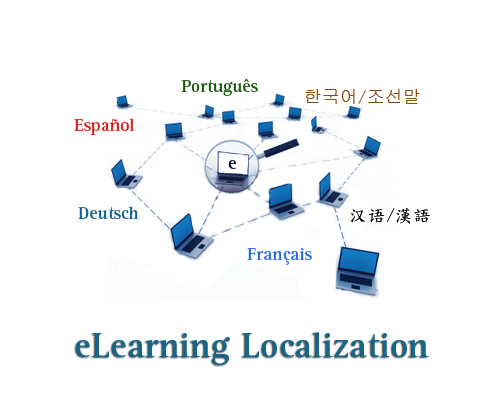eLearning Localization: Multicultural or Multiple Cultures?
Frequently in the U.S., when we talk about culture, we are speaking of what we commonly refer to as diversity. For most Americans, the term diversity reflects the socio-cultural makeup of our workplace. However, when GPI speaks of localization, we are typically referring to adapting educational materials for people in other countries. Thus, when you submit classroom or online training courses to us for localization, we request information from you about the targeted learners because we use different approaches to localization, based on whether your learners are a U.S.-based multicultural group or in different countries. Why?
|
|
 |
Compare these two figures. Figure 1 represents a U.S. corporation with a multicultural workforce. In this figure, we assume that your targeted learners are primarily second generation or later Americans (the black dots), but with several first generation cultural groups represented (colored circles), as well. Thus, localizing training for a multicultural group will most likely require modifications that accommodate learners with less exposure to U.S. culture and/or more affinity for one’s native culture.
Figure 2 represents a U.S. corporation that has business affairs in other countries. In this situation, you typically regard the U.S. learners as a homogenous cultural group and then modify the U.S.-designed course to accommodate learners in each of the targeted countries, removing “Americanisms” and then localizing aversion of the course for each distinct culture or cultural group.
Let’s look at an example to illustrate how our approaches to localization differ, depending on which of these two typical situations is represented. In this blog, we’ll address localization for a multicultural group. In our subsequent blog, we’ll compare multicultural localization to localizing for a global audience.
eLearning Localization
As we’ve mentioned in previous blogs about eLearning translation and Localization, we typically adapt elearning courses by analyzing content, instructional approach, and course technology to determine:
A. How it aligns to learners’ preferences and expectations.
B. How we can make adaptations that are critical to the achievement of equitable learning outcomes.
With respect to content, we localize language (Global English) and confirm that content is contextually relevant. For instructional approach, we ensure that course activities, including assessments, are culturally accessible and palatable. Lastly, we examine media to ensure that images, icons, and so forth are contextualized and that the targeted learners’ environment supports these technologies.
Localization for Multicultural Audiences
In the multicultural audiences, the learners are immersed, foremost, in American culture; however, the learners from cultural sub-groupsusually retain many preferences and expectations for the learning environment that they experienced ‘back home.’ Thus, localization of materials for this multicultural group requires that we address the group as one culture – working within one company or within an industry – and yet, as multiple cultures that have cultural differences that could affect learning outcomes. For our example, imagine that the learners are owners or managers of U.S. convenience stores. They are mostly males, well educated, ranging in age from 35-50. The majority of them, about 70%, are white males. The remaining 30% are first generation Americans, mostly non-white males from India and Pakistan. What differences might exist, with respect to learning, and how might we localize elearning to account for them?
Language
Typically, non-native English speakers will struggle, to varying degrees, with language. If you have ever studied a second language or visited a country where residents did not speak English, you understand the challenges and frustrations that accompany a lack of fluency. Now, imagine you are taking an online course in which the content is wordy, complex, and full of colloquialisms and jargon. First, it’s difficult to even read the materials! Second, the videos are difficult to comprehend whenthe speaker talks fast or has an accent. Thus, the simplest form of localization for any American elearning course is to use Global English:
- Excellent punctuation, grammar, and spelling
- Short, simple, and concise sentences
- Elimination of synonyms, jargon, colloquialisms
- Explanations of unique terms, and so forth
Using the principles of Global English will decrease the time needed to read the content, improve comprehension, and – if you plan to translate the words and media – decrease translation costs by 30-50%.

Context
It’s very easy to make assumptions about context. For example, we assume that all convenience store owners are financially motivated – that they conduct business for the sole purpose of gaining income. Yet, in many non-U.S. cultures, people are motivated by family more than money. Thus, if you want to encourage your learners to adopt a new business technique like upselling, you’ll want to link that behavior or desirable activity to multiple motivators, not just cash. For example, instead of expecting money to be the ‘final’ motivator, you could instead refer to the increased income generated by upselling as a mean to other ends, such as creating more jobs (potentially for family members, if it’s allowed), supporting an extended family, etc. Thus, you can see the importance of knowing quite a bit about your targeted learners and, if they work for you, you should have access to group demographics.
In contrast, if your training course seeks to discourage non-productive business behaviors, like poor customer service or poorly maintained convenience stores, you need to understand how your learners perceive ‘good’ customer service and ‘cleanliness.’ For example, if the learners come from countries where service is simply defined as ‘receiving the product or service’ – without smiles or greetings, whether the cashier line is long or short – then your course content may need to address that context. We can help you do this in several ways, from rewording the content to using feedback mechanisms in an online course. When we conduct a cultural audit, we provide you with concise explanations as to why certain content may be irrelevant to certain groups of learners and how you can modify it.
In addition, if you refer back to Figure 1, you can see that some of the cultural groups overlap. This indicates that, while they are different, they have certain characteristics in common. Thus, one approach to addressing cultural differences is to identify those overlaps and localize your course to address commonalities. For example, convenience store owners from India and Pakistan may be very business astute since both their countries are experiencing significant economic growth. Thus, you may find that, in contrast to the ‘older generation’, these younger, educated store owners are motivated by cash and short-term gain, much like their American counterparts.
Conclusion
Localizing your training courses and materials, whether destined for the classroom or online, requires a different approach if you are localizing for a multicultural group of learners or for learners in multiple different countries. When you work with GPI, we ask questions about the goals of your course(s), the demographics of your targeted learners, and your business goals. In the cultural audit of your training materials, we identify these cultural nuances and test them for you. In this manner, you can be sure that your targeted learners, wherever they are, will achieve those desired learning outcomes.
eLearning Localization and Translation Services
GPI, a premiere translation company, provides comprehensive localization and translation services for eLearning and training courses. Our elearning localization team will help you translate your elearning courses and presentations in all languages.

